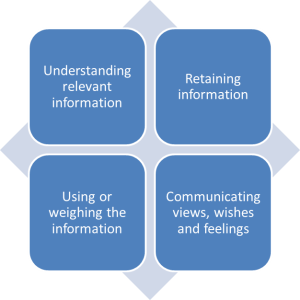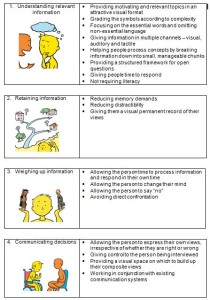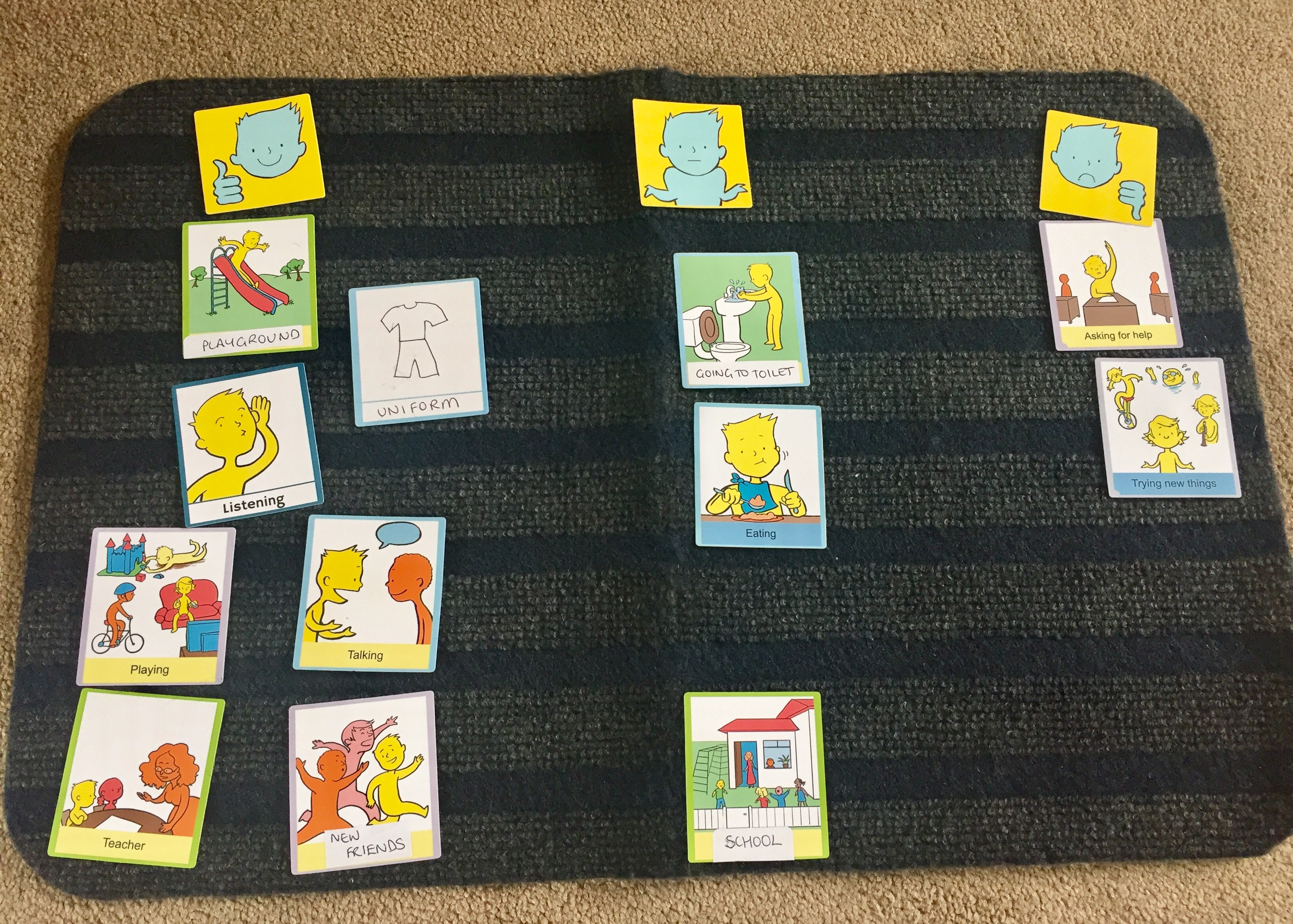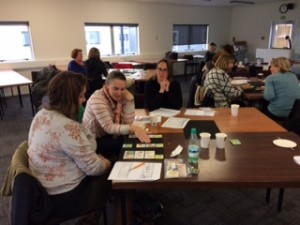This story, which highlights the importance of finding out what really matters to people, was shared by one of the staff attending the second day of an enhanced Talking Mats training course. She works in a NHS facility for people assessed as needing hospital-based continuing care.
I was working with Bill (not his real name) who is a man with severe cognitive impairment resulting from a head injury and stroke. He was very angry and agitated and we couldn’t work out what was wrong. At times he was physically aggressive when we couldn’t understand him.
One day he drew a picture of a rabbit and was very insistent about it but we didn’t know what it meant. We contacted his sister about him being angry about a rabbit. She asked around to other family members and friends but no one could think what it meant.
Bill continued to draw a rabbit and then other pictures including money and TV so I made an improvised Talking Mat using his drawings as the options and began trying to find out what really mattered to him. I gradually connected that the TV was about about programme called Dickinson’s Real Deal (a TV programme about antiques) and that in the past Bill had had an ornament of a rabbit which he thought was worth a lot of money.
We phoned his sister again about a possible rabbit ornament and she then remembered that he had collected figurines in the past. She finally discovered the rabbit in her garage.
Once we were able to reassure Bill that his rabbit was safe his frustration lessened,he was much less angry and became more settled.
This lovely story shows us how important it is to never assume that someone is just ‘being difficult’ but that if we can try to find out what really matters to them we can make a huge difference to their lives and ours.
This is the second in a two part discussion on decision making and determining capacity, this time looking at how Talking Mats can help. Click here for the previous blog
Where Talking Mats comes into play is by allowing people to consider each option around a decision and then make their decision when they place the symbol under the appropriate top scale. We have found that many people, who would otherwise be judged not to have capacity, can show that they can indeed understand and express their views so that they can be acted upon. Equally our work so far indicates that if someone cannot use Talking Mats this may be an indication that they do not have capacity for that particular decision.
Talking Mats supports the four criteria which are required in determining mental capacity. The table below lists some of the elements which Talking Mats provides to support each of the 4 criteria.
(Click on the image to enlarge)
Are these 4 criteria applicable and helpful in your setting?
Thanks to Natalie Leader, one of our Accredited Trainers from Hobart, Australia for this blog reflecting on her experience of doing the online Foundation training.
The beauty of online training is that no matter where you are or what time zone you’re in, there are options. This is really brought to bear when living in a rural or remote area, such as here in Southern Tasmania.No matter how much those of us here in beautiful Tassie brag about what an awesome place it is to visit, there are limits as to which training organisations will provide professional development sessions here, and how often.
I missed an opportunity to attend Talking Mats Foundation training by a few months so registered to do the online training instead.
My experience with the Talking Mats online training platform was that the organisers were responsive and positive, and the content offered variety, with steady monitoring of progress. Amongst the easy navigation and helpful resources you also participate in discussion forums. As one who doesn’t often participate on line, I found them encouraging and helpful, It was also interesting to read people’s descriptions of different ways that Talking Mats can be used.
Doing the modules in sequence (and with some time in between) worked well for me, as I reflected more deeply on the role of the listener and the qualities I needed to foster in my practice, such as observation, pacing and neutrality.Fostering those qualities and being guided by principles such as self-determination is now an ongoing goal for me.
I have now introduced Talking Mats into my practice and have taken the next step of becoming an Accredited Trainer.
Becoming an accredited trainer involved attending a 2-day workshop in Melbourne for face-to-face training and assessment from Lois and Nicki from Talking Mats Ltd, Stirling, Scotland. As if having excellent trainers was not enough, there was the added bonus of a roomful of like-minded practitioners, all sharing their skills and experiences with Talking Mats. Because each person’s work setting was unique, our group had a rich and diverse array of perspectives on implementation of Talking Mats training and techniques.
So, now I’m making preparations for delivering my first training workshop, sharing Talking Mats with my colleagues. I actually don’t have the jitters (except regarding the IT!) And, I’m confident that Talking Mats will speak for itself. Perhaps I may have appeased the IT deities by taking a giant leap from my former self and participating in a blog, so that side of things will run smoothly!
Good luck with the training Natalie!
This month we have online course participants from Singapore, Canada, Ireland and the UK. Register now for our next online training starting on the 5th of September.
Laura’s 4 year old twin boys are just about to start school and she was finding it difficult to have a proper chat with them about how they are feeling. She wanted to think about how best to help them prepare for the transition from nursery so used Talking Mats.
We have done lots of ‘practice mats’ over the past few months – focusing on topics such as ‘food’, ‘animals, and ‘toys/games’, so I knew that the boys were both familiar with Talking Mats before I introduced the more emotive topic of ‘School’.
P was first to have a go at being a ‘Thinker’, with me as the ‘Listener’. We used the Top Scale ‘Happy about/ Not Sure/ Not Happy About’. P thought very hard about placing each option. It helped to have the pictures and mat to focus on rather than just me firing questions at him.
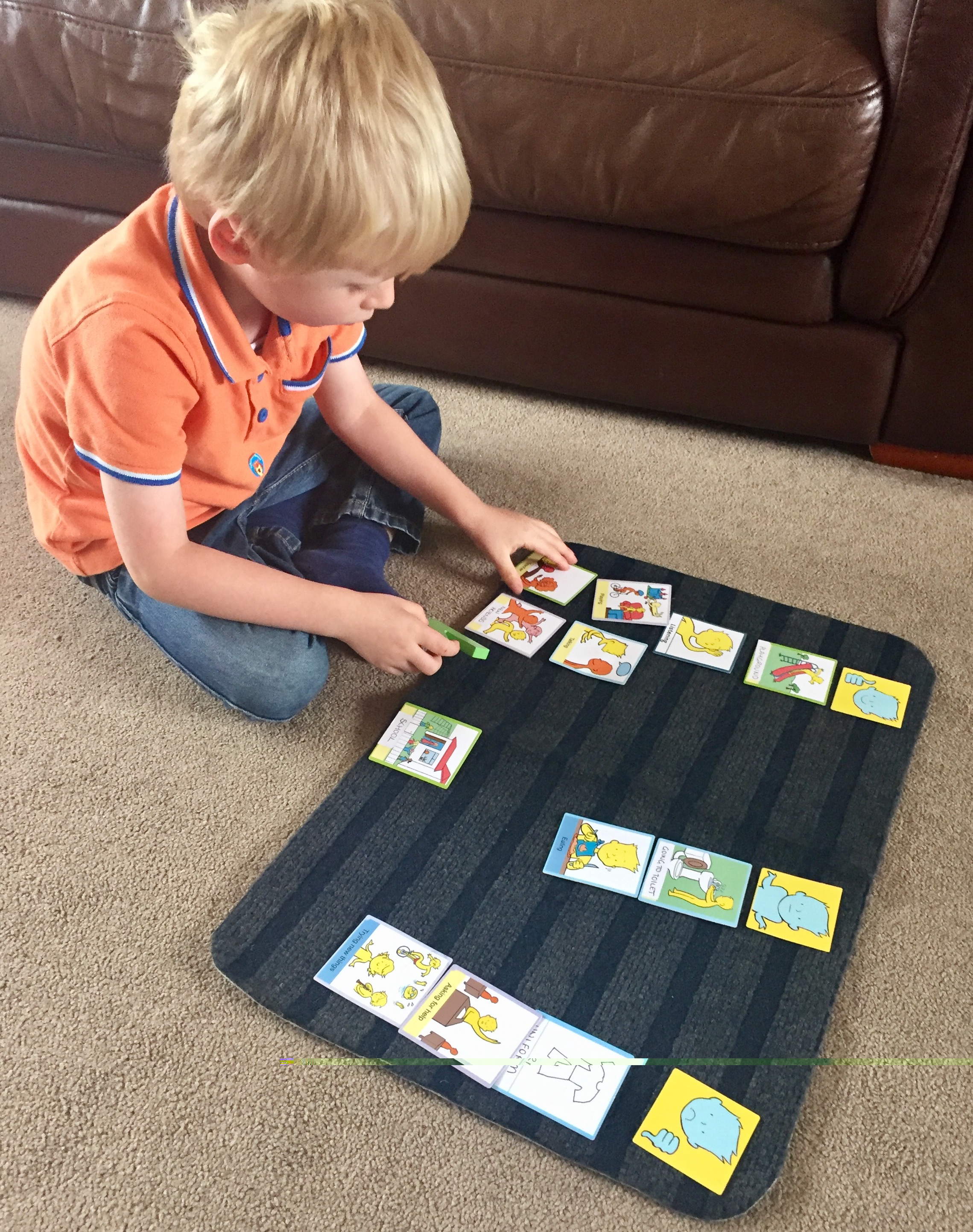
P’s finished mat gives us a clear indication of his feelings about school. The ‘check and change’ stage was very useful as P changed his mind about ‘uniform’ which he had originally placed under ‘Not Happy About’ – he said that actually he is happy because he will look smart in his new uniform!
The Talking Mats Keeping Safe Learning Disability projects ends but a resource that promotes safeguarding and well-being continues.
The Keeping Safe Talking Mat provides a structured framework to ask someone ’How’s your life going? We are grateful to the Scottish Government Keys to Life monies for funding the trials. Impact of use of the resource was gained by practitioners sending in examples of their use of Keeping Safe, and the outcomes and actions from the Mats were themed.
The resource has been shown as a helpful way to
- discuss new information (89%). Staff frequently commented that using the Mats revealed things they had not known previously.
- discuss and resolve fears (84%) . It provided a framework that was supportive for those more difficult and or sensitive conversations e.g.’ Usually when she expresses her feelings she can get either upset or angry. She did not get upset or angry at any point through doing the Talking Mats, although the subject and things she was saying was at times difficult issues.’
- support thinking (89%) ‘It helps with memory and attention as she has something visual to keep her focused.’
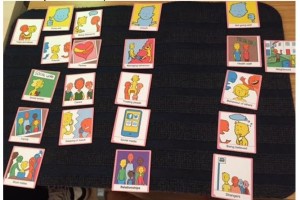
Initially many staff thought using the resource would take too much time but in fact were really surprised to find how much quality information they got in a short space of time. A cost benefit analysis demonstrated that using the Keeping Safe resource is cost effective for organisations i.e. for every £1.00 an organisation spends on the training and the resource, the potential financial benefit to the organisation is £23.00. We believe this is because the Mats create a powerful listening space and so that issues can be addressed timeously and not spiral out of control. This has not only a financial benefit but also a return in terms of an individual’s well-being and access to local non specialist services.
Although this resource was developed with adults with a learning disability, several people have reported that they have found it useful with other client groups e.g. adults with acquired neurological disorders and young people particularly with mental health issues .
If you want to read in more detail about the design process behind the resource then please read this journal article published in the Tizard Learning Disability Review More Than Pictures TLDR 2017
When considering someone’s mental capacity its is important to bear in mind that the right to self-determination is enshrined in law.
In 1948 Eleanor Roosevelt, as the chair of the United Nations Human Rights Commission, was the driving force in creating the Universal Declaration of Human Rights Act (1948).
Since 1948 there have been laws passed in many countries stating that people with communication disabilities should have equal rights, including and specifically in the complex area of mental capacity. In the United States the Federal Law that covers this is the Americans with Disabilities Act of 1990 . In the UK the key Acts of Parliament are the Mental Capacity Act (2005) England and Wales and the Adults with Incapacity Scotland Act (2000).
The UK Acts specifically focus on mental capacity and say that every adult has the right to make decisions unless proved otherwise and that each individual has a different capacity to make decisions about different aspects of their life. In addition they state that we must assume that someone has Capacity unless it is established that the person has substantial difficulty in one or more of the following criteria in the following diagram.
There are a number of important expectations behind these Acts which are particularly significant for people with communication difficulties.
- Everyone should be supported to make their own decisions (including Augmentative and Alternative Communication methods)
- Adults should be encouraged to make use of their skills and to learn new ones where that would be helpful
- Information to support understanding needs to be given in a way that is appropriate to his/her circumstances (using simple language, visual aids or any other means).
- People are entitled to make their decision – this is not about what we think is good or bad
- Judgements on capacity:
- cannot be based on age, behaviour or disability
- need to be made decision by decision – (so not being able to make more complicated decisions does not apply to all decisions)
- cannot be based on past experience of decisions – they need to focused on the here and now
- must take into account the adults socio-cultural circumstances wherever relevant
- where a person is able to retain the information relevant to a decision for a short period only, this should not prevent him or her from being regarded as able to make the decision
- If someone is judged to lack capacity then decisions must be in their best interest and any measures taken on their behalf are to be the least restrictive to the person
- It is important to assess people when they are in the best state to make the decision
Please let us know how you deal with self-determination and capacity issues where you work.
In a future post I will explain how Talking Mats can help support decision making and the identification of Capacity.
Involving people with a learning disability in service evaluation is both essential and challenging.
Maria Lavery speech and language therapist, and her colleagues in North and South Lanarkshire are using Talking Mats to get feedback about the service they deliver for people with a learning disability . They want to find out about what people feel they do well, and what could be done differently. In addition they have placed a suggestion box at the entrance to their building, but want to involve everyone who is connected with their service – clients, family, carers various multi-agency colleagues and are carrying the review out over a 6 month period.
The analysis and learning will be used to inform the Speech & Language Therapy work plan and support the future direction of the service.
Talking Mats has been used successfully to evaluate Augmentative and Alternative Communication services and the resource for this is available on our website http://www.talkingmats.com/wp-content/uploads/2013/09/AAC-service-Evaluation-script-and-symbols.pdf
We are currently working to develop a Talking Mats resource to support conversations relating to Advance Care Planning (ACP) with staff and patients from Strathcarron Hospice. People who use hospices often have specific difficulties communicating their thoughts and feelings because of advanced illness and emotional factors.
Sixteen staff from the multidisciplinary team at Strathcarron Hospice were trained to use Talking Mats by Sally Boa who is Head of Education, Research and Practice Development at Strathcarron Hospice and also one of our accredited trainers.The staff trained used it successfully with patients in the hospice and found that they could use it with a range of patients for a variety of purposes: getting to know someone; identifying goals; discharge planning.
A sub-group of staff attended a workshop with members of the Talking Mats team to discuss the potential use of Talking Mats to support conversations relating to ACP. Topics and options were agreed. These were then presented to a wider forum of staff from Highland Hospice for validation and checking. Three main topics to support ACP conversations were identified: Affairs; Care and Personal Values. New symbols are being developed and the resource will be trialled with a range of patients in the hospice setting.
Our hope is that Talking Mats can be used by trained staff in a hospice setting to support people to express their views and help them plan for the end of life and that it will also be helpful for many other people to consider future options in their lives.
We will write an update once the new resource has been completed.
Laura Holmes was pleased to meet up with Rachel Clemow, Head Teacher and Donna Wood, Education Support Worker who work for the Virtual Schools Team in Wigan to find out about the impact of Talking Mats training.
Donna accessed a Talking Mats Training last year delivered by a Talking Mats accredited Trainer in Wigan Educational Psychology service and quickly put her training into practice with the children that she works with, using the Consulting Children and Young People – Primary resource pack. Other members of the team soon recognised the potential benefits of introducing this approach themselves, and so, in April 2017, a further 15 members of the Virtual Schools Team received Talking Mats training.
Looked After Children can often struggle to express their thoughts and feelings, often as a result of their situation/ circumstances. This can be further compounded if they also present with speech, language and communication difficulties. There is a higher risk of such difficulties within the LAC population (Cross 1999 ).
Often there are many professionals involved with a Looked After Child, all asking a wide variety of questions, some of which can be highly personal and/or emotive in nature. The team have observed that children will sometimes end up giving answers which they think the listener wants to hear, rather than answers which reflect their true feelings/views – or the child may withdraw from the process entirely. Consequently, it can be very difficult to ensure that the true ‘voice of the child’ is being heard. Sometimes the children themselves struggle to understand what their own feelings are – often the topics and questions can be complex and involve abstract concepts.
Rachel and Donna report that the Talking Mats approach has had a big impact on their communication style when working with the children on their caseloads, and has enabled children to express their thoughts and views in a safe, neutral environment. Some of the comments they made about Talking Mats were that it:
– Enables the listener to get to know a child quicker and more easily as there is no pressure/expectation of the ‘thinker’ – it is a child/’thinker’ led approach.
– Provides way of supporting the child to open up to express their views and feelings, even if they have previously been hard to engage – and for the child to develop better insight into their own feelings.
– Helps to avoid the possibility of adult/listener misinterpretation of what the child is trying to communicate.
– Enables the child to focus on pictures – which appears to result in the child being more comfortable in expressing their own views and feelings – as opposed to what the child thinks the listener wants to hear.
– Provides a holistic view of the child – which can support target setting and planning at key stages for that child, for example, transition to High School.
– Gives the child something they can be successful at – there are no ‘wrong’ answers.
Donna shared a great example of how Talking Mats helped a young girl to describe an issue at home which she had not shared with any carers or school staff previously. The child placed the ‘home’ option symbol on the ‘not happy’ section of the mat then began to whisper to Donna explaining the reason why. This resulted in Donna being able to share the information with school staff and social care, consequently, the issue was resolved.
Services, organisations and schools in Wigan are already using the Talking Mats approach as a result of widespread training delivered by our Accredited trainers in the Educational Psychology Team. This provides a great example of how using Talking Mats across agencies can really help a whole area to become more child/ young person led.
The Virtual Schools team are now recommending the Talking Mats approach to other agencies working with the Looked After Children on their caseloads, such as adoption and fostering services.
If want to access the training then there are Talking Mats foundation courses run regularly in London, Stirling , Manchester and Newcastle . Once you have attended a foundation training and gained experience you can apply to become an accredited trainer .
This is the second blog about Lois and Nicki’s amazing visit to Australasia – this time theirTalking Mats trip to New Zealand.
The view flying into New Zealand was dramatic. We looked down on a beautiful range of snow topped mountains glistening in the clear blue sky as our plane flew towards Christchurch. Our first stop was the South island for a foundation training organised by Talk Link. Our second foundation training was in Auckland in the North Island. At both places we had a fantastic group of interested practitioners who really engaged with how Talking Mats could be used and began thinking creatively about how they would apply in their work place .This included:
• Involving thinkers in decisions about the their alternative and augmentative communication and getting feedback on what works for them
• Exploring its value for young people in the youth justice system to support them to express their views and be a tool for increasing engagement
• Exploring how Talking Mats could be adapted to make them more accessible and culturally accepted to the Maori community
• Involving children in their education planning
We were really pleased that Talk Link also sent 3 staff to the accredited training course in Australia. This means that there will be increased access to Talking Mats Foundation training in New Zealand for the future. Our experience is that accredited trainers provide leadership that helps organisations embed Talking Mats into practice. Thanks to Ann Smaill for all her organising and support for both our Foundation and Accredited courses.
And our leisure times were special too. We had a trip on the Christchurch Gondola to see the stunning Banks peninsula; we experienced the hope and resilience of Christchurch following the earthquakes in 2010 and 2011. In Auckland we saw a thought provoking Maori exhibition and last but not least we loved our weekend of rest and relaxation on the very special island of Waiheke. The locals thought us mad to swim in the sea their autumn but we loved it!
More information
Click for more information if you want to find out about
 Online training login
Online training login 

